John Haynes
-
- Crew System Integration on RHIBs and High Speed Craft Maritime Reporter, May 2013 #22
Human Systems Integration (HSI) is a recognized requirement for many organizations. This is rapidly becoming more important as the professional RHIB and high speed craft sector are required to perform increasingly complex tasks. The objective is for marine units to deal with new scenarios, make fast decisions and implement them using high speed craft and specialist equipment to achieve successful outcomes.
Crew-Systems Integration (CSI) brings together all these elements for the fast boat sector. The challenge for all professional organizations is the integration aspect of the many disparate areas that are required to deliver enhanced performance and safety. To highlight how a number of CSI domains integrate for the marine sector, the graphical interpretation of Crew-Systems Integration is used (see diagram, next page). FRC International is an education, training and qualification developer for Fast Response Craft (FRC) personnel. The innovative approach includes understanding risk, duty-of-care, legislation, evolving technologies, new operational tasks and scenarios. FRC training recognizes the growing need for professional and commercial maritime operators to be interoperable with other agencies and assets. A set of competence-based international qualifications has been recognized by The Nautical Institute to support best practice for military, professional and commercial marine organizations worldwide.
FRC International is hosting the CSI 2013 conference, an event that will attract end-user organizations and industry from around the world. It will cover the full range of factors that deliver performance and safety for the crew and operating organization. The topics that will be covered include Crew, Craft & Equipment, Training and the interface between them. Human Factors Engineering which can be linked to defined Qualifications and Simulation. To complete the integration picture the conference will also focus on Repeated Shock & Whole Body Vibration, Unmanned Vehicles and Operations. These nine topics can be considered separately but ultimately the challenge is linking them up.
Craft & Equipment
The sub 80 ft. (24 m) sector is developing at a rapid pace. Not only has this resulted in increased boat speed and capability but new technologies and systems are available both for new craft and as retrofits. Boat builders now need to understand the level of test and evaluation that their craft will go through as part of a tender process. Equipment manufacturers need to develop electronics and equipment to international standards and where appropriate military specifications. Seat manufacturers will now have the opportunity to integrate new international testing standards into their development process. The conference will highlight the latest innovations and how operators can incorporate these developments into their requirements.
Crew
This increasing operational capability facilitated by enhanced craft no longer means that the vessel is simple to operate within the full operational envelope. Slow speeds and benign environments are relatively simple to operate in, but as speed increases, the environment deteriorates. As systems become more complex the competencies demanded of the crew move to a higher level and are more like those required by a helicopter crew where effective situational awareness and Command & Control (C2) become crucial for performance and safety. The needs of regular passengers increasingly need to be considered by the crew as they are often being transported at speed to perform tasks on a fixed or moving platform. This includes ships pilots, boarding teams and wind farm engineers. The conference will examine demands on crew and passengers and how the crew may be supported to overcome these.
Training
As the capability of the craft and its systems have advanced the crew, in evolutionary terms, remains unchanged and can be outperformed by the craft. To counter this a part of the integrated solution is enhanced training. Boats very rarely operate alone and so standardization is required to ensure effective interoperability. This ranges from teamwork between two boats to multiple craft operating together in coalition operations. The conference will examine current developments in training programs and Standard Operating Procedures (SOPs) and how they are being developed and disseminated to the global community.
Human Factors Engineering (HFE)
With new and retrofitted craft being capable of out-performing the crew it is essential that the designers focus on designing for the human crew to ensure that they can operate the craft at the edge of its operating envelope to ensure operational success and safety for the crew and their passengers. The conference will highlight developments in HFE, often called ergonomics, specific to fast craft design and operations.
Qualifications
Qualifications help to differentiate between individuals. They also allow marine employers to recruit good crew members and provide them with a developmental career structure. Qualifications are the foundation of Standardization-for-Interoperability. It is essential that the international marine community have a qualification system that provides minimum standards of competence. The system also needs to demonstrate the advanced competencies required to operate the advanced systems and procedures now being deployed on RHIBs and high speed craft.
The conference will highlight the work being undertaken to develop qualifications appropriate to the professional sub 80 ft. (24 m) sector and how these can be utilized by the international community.
Simulation
For ship maritime operations, including bridge and control room, simulation is recognized as an effective training tool. In other sectors, including aviation, it is an essential training tool.
The sub 24m sector has not yet effectively embraced simulation but this is about to change.
There are many reasons for this but a fundamental requirement is the increasing deployment of sophisticated electronic systems for those operating at high speed in demanding environments. Relevant simulation can be used to effectively support training and qualification programs.
It can provide a controlled environment that does not require use of a boat or fuel. The conference will highlight the different types of simulation and how operators can effectively use simulation to enhance operational effectiveness and safety.
Whole Body Vibration & Repeated Shock (WBV & RS)
The risks of exposing fast craft crews and passengers to WBV & RS have now been recognized. Systems have been developed to reduce or manage the exposure. Besides the obvious risk of acute and chronic injury RS & WBV can induce fatigue and degrade the interaction between the crew and the craft. The drive for legal compliance within the EU and employers needing to demonstrate duty-of-care in the rest of the world has driven the pace of development. Although reducing the risk to zero is virtually impossible for planing craft at sea, operators are now engaging with the concept of ALARP (As Low As Reasonably Practicable). The conference will highlight developments related to the management and control of exposure to WBV & RS.
Unmanned Surface Vehicles (USV)
The rapid development of unmanned vessels and systems is due to a number of factors. The drive for reduced manning can be due to cost and recruitment issues. The manning of craft can constrain the operational envelope and in certain applications ‘unmanned’ can simply remove the human from harms way. Although remote control systems are not new, the technical developments that are leading to more autonomous systems are changing the face of fast craft operations. The conference will highlight the developments in unmanned systems and the opportunities for the marine sector that these developments bring.
Operations
For the modern RHIB and high speed craft organization all of the topics described above then need to be integrated to deliver operational capability.
The technical developments and systems to support human effectiveness provide the ability to either enhance the operational envelope or provide more resilience within the system for current operations. The conference will examine how fast craft operations are changing and what the future may hold for the crews and their organisations.
Emerging maritime nations have the opportunity to use the integration template to develop fast craft capabilities based on international best practice. For established maritime organizations the challenge in these times of austerity is having clear reasons for where to apply their efforts and budgets when replacing or upgrading craft. This approach can benefit all sectors from ships being replaced with multiple small craft fleets to the challenges of renewable energy support craft.
FRC International are hosting the CSI 2013 conference at the RNLI College in Poole UK from July 2-4, 2013. Dr Trevor Dobbins, Technical Director of FRC International, said, “the 2013 event has a focused program that includes more than 20 presentations by international experts. The objective is to bring together all the topics of Crew Systems Integration to show how marine operations in all sectors can benefit from a joined up approach.” The conference also gives industry the opportunity to participate with an exhibition area designed to highlight the latest developments in technology for RHIBs and high speed craft.
CSI 2013 is an independent event that is relevant to all professional operators, boat builders, equipment manufacturers and designers. To highlight the importance of CSI for the international community keynote presentations are by leading experts including, former Royal Navy Rear Admiral Chris Parry, who was Director of Concept and Doctrine Development for the UK Ministry of Defence, and is now a noted strategic consultant and geopolitical forecaster.
For further information see CSI 2013 Conference www.frc-int.comJohn Haynes, AFNI, is Operations Director of FRC International and a presenter of WBV courses. He is a Yachtmaster Ocean and Advanced Powerboat Instructor. Subject matter expertise includes high speed craft consultancy, product development and specialist training. [email protected]
(As published in the May 2013 edition of Maritime Reporter & Engineering News - www.marinelink.com) -
- A Closer Look at Dynamic Navigation for High Speed Craft Marine News, Dec 2013 #22
FRC International launched the innovative ‘DYNAV’ dynamic navigation system for high speed craft at Chalmers University of Technology in Gothenburg, Sweden in October. The DYNAV launch event enabled attendees from Scandinavia and Europe to come together with the objective of improving seafarer safety
-
- With an Interceptor, a RHIB and a Cat Maritime Reporter, Mar 2014 #40
to all the racers and support teams that made the 2013 Americas Cup an outstanding event and raised the bar for power versus sail. The Author John Haynes, AFNI, is a Yachtmaster Ocean and Advanced Powerboat Instructor. Subject matter expertise includes high speed craft consultancy, product development
-
- Fast Craft and Innovative COTS Solutions Marine News, Jun 2014 #28
Many variables drive the design decisions for High Speed Craft and RHIBS. Commercial off the Shelf Solutions often tie all of these together. The world is changing fast and nowhere is this truer than in the fast boat sector. When selecting a new boat, the questions used to be relatively simple: how
-
- Innovative Propulsion Systems for Fast Craft Marine News, Jul 2014 #40
Performance, Speed, Fuel Economy & Environmental compliance all come together to form the ultimate balancing act for engine OEM’s and their customers alike. The ‘need for speed’ has been at the heart of professional fast craft operations since powerboats first overtook their bow wave and went on the plane.
-
- Extreme Applications Demand Specialist Small Craft Marine News, Oct 2014 #34
. Extreme applications that may drive demand for this next generation of small USVs include the 3Ds – tasks that are Dull, Dirty and Dangerous. John Haynes is an Associate Fellow of The Nautical Institute, Yachtmaster Ocean and Advanced Powerboat Instructor. Subject matter expertise includes high speed
-
- Next Generation Shock Mitigation for Fast Boats Marine News, Nov 2014 #70
term capability all depend on how an organization takes care of passengers and the skill of the coxswain to drive according to the sea conditions. John Haynes is an Associate Fellow of The Nautical Institute, Yachtmaster Ocean and Advanced Powerboat Instructor. Subject matter expertise includes high speed
-
- Hybrid Power for Workboats: The Future is Now Marine News, May 2015 #28
Hybrid marine power and propulsion systems for workboats isn’t farfetched. In fact, it may be essential. In 2015, two significant developments are going to make many operators, owners and builders of professional vessels consider hybrid marine power. The new emissions laws – here and abroad – and the
-
- Design & Operation: Wind Farm Support Vessels Maritime Reporter, May 2015 #36
. There are lessons to be learned from northern Europe which accounts for the US ‘start smart’ approach to offshore renewable energy. The Author John Haynes is an Associate Fellow of the Nautical Institute, a Yachtmaster Ocean and Advanced Powerboat Instructor. Subject matter expertise includes high
-
- The 'Hour of Power': Hybrid Marine Technology & Green Ports Maritime Reporter, Jul 2015 #35
and naval architects are now investigating systems for survey vessels, superyacht tenders, patrol vessels and unmanned craft. The Author John Haynes is an Associate Fellow of The Nautical Institute, Yachtmaster Ocean and Advanced Powerboat Instructor. Subject matter expertise includes high speed
-
- The Hour of Power Maritime Reporter, Aug 2015 #64
rapidly towards hybrid solutions it will be interesting to see how the marine industry decides to utilize the numerous opportunities. The Author John Haynes is an Associate Fellow of the Nautical Institute, a Yachtmaster Ocean and Advanced Powerboat Instructor. Subject matter expertise includes high
-
- Riders on the Storm Marine News, Oct 2015 #38
. For professional ‘Riders on the Storm,’ this can minimize downtime from injuries and extend the working life of maritime professionals. The Author John Haynes is an Associate Fellow of the Nautical Institute, a Yachtmaster Ocean and Advanced Powerboat Instructor. Subject matter expertise includes high
-
 )
March 2024 - Marine Technology Reporter page: 4
)
March 2024 - Marine Technology Reporter page: 4; Fax: (212) 254-6271 tional in London, perennially one Lof the world’s most important Justin Zuure CEO events serving the global subsea market. John C. O’Malley [email protected] Personally, it was my ? rst return to London for this event since 2018, as the 2020 ‘50th Anniversary’ edition
-
 )
April 2024 - Maritime Reporter and Engineering News page: 28
)
April 2024 - Maritime Reporter and Engineering News page: 28to provide all of the end-to-end logistics the force will require in a future major con? ict. U.S. Navy photo by Mass Communication Specialist 2nd Class John Bellino 28 Maritime Reporter & Engineering News • April 2024 MR #4 (18-33).indd 28 4/5/2024 8:27:05 A
-
 )
April 2024 - Maritime Reporter and Engineering News page: 27
)
April 2024 - Maritime Reporter and Engineering News page: 27Sailors. We have 14 Henry J. Kaiser-class ? eet replen- high-speed craft (HSC) training. So, MyMSC will help track ishment oilers and three of the new John Lewis class of ? eet and manage all of those different things in one place. We’re replenishment oilers, with more on the way. We have 14 Lew- hoping
-
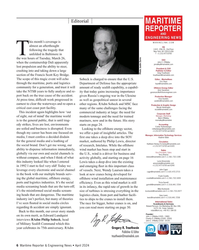 )
April 2024 - Maritime Reporter and Engineering News page: 6
)
April 2024 - Maritime Reporter and Engineering News page: 6St., 2nd Floor following the tragedy that New York, NY 10010 USA T +1.212.477.6700 Tunfolded in Baltimore in the wee hours of Tuesday, March 26, CEO John C. O’Malley when the containership Dali apparently [email protected] lost propulsion and the ability to steer, President & COO Publisher & Editor cra
-
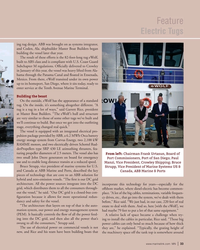 )
April 2024 - Marine News page: 33
)
April 2024 - Marine News page: 33SRP 430 LE azimuthing thrusters, fea- turing propeller diameters of 2.5 meters. The vessel also has From left: Chairman Frank Urtasun, Board of two small John Deere generators on board for emergency Port Commissioners, Port of San Diego; Paul use and to enable long distance transits at a reduced speed. Manzi
-
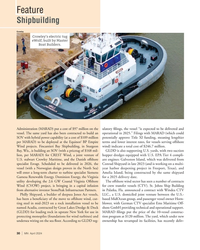 )
April 2024 - Marine News page: 30
)
April 2024 - Marine News page: 30The offshore wind sector has seen a number of contracts Wind (CVOW) project, is bringing in a capital infusion for crew transfer vessels (CTV). St. Johns Ship Building from alternative investor StonePeak Infrastructure Partners. in Palatka, Fla. announced a contract with Windea CTV Philly Shipyard
-
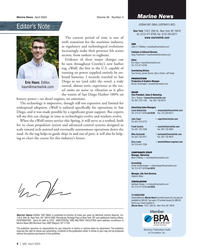 )
April 2024 - Marine News page: 4
)
April 2024 - Marine News page: 4.marinelink.com The current period of time is one of swift transition for the maritime industry, CEO as regulatory and technological evolutions John C. O’Malley • [email protected] increasingly make their presence felt across Publisher & Editorial Director Greg Trauthwein • trauthwein@marinelink
-
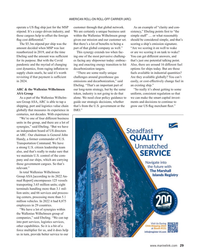 )
February 2024 - Maritime Reporter and Engineering News page: 29
)
February 2024 - Maritime Reporter and Engineering News page: 29units in the group, and there are a lot of synergies,” said Ebeling. “But we have an independent board of US directors at ARC. Our chairman is General John Handy, a former commander of U.S. Transportation Command. We have a strong U.S. citizen leadership team also, and that’s really to make sure that
-
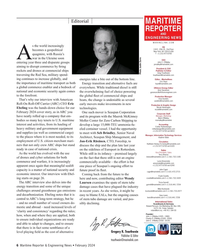 )
February 2024 - Maritime Reporter and Engineering News page: 6
)
February 2024 - Maritime Reporter and Engineering News page: 6HQ 118 E. 25th St., 2nd Floor becomes a geopolitical New York, NY 10010 USA T +1.212.477.6700 quagmire, with Russia’s Awar in the Ukraine soon CEO John C. O’Malley entering year three and disparate groups [email protected] aiming to disrupt commerce by ? ring President & COO Publisher & Editor rocke
-
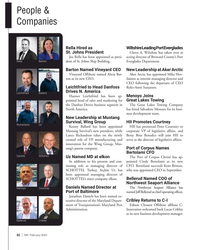 )
February 2024 - Marine News page: 42
)
February 2024 - Marine News page: 42People & Companies Rella Hired as Wiltshire Leading Port Everglades St. Johns President Glenn A. Wiltshire has taken over as Joe Rella has been appointed as presi- acting director of Broward County’s Port Rella Barton dent of St. Johns Ship Building. Everglades Department. Barton Named Vineyard CEO New
-
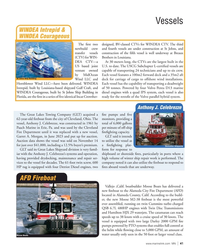 )
February 2024 - Marine News page: 41
)
February 2024 - Marine News page: 41& WINDEA Courageous The ? rst two designed, BV-classed CTVs for WINDEA CTV. The third newbuild crew and fourth vessels are under construction at St Johns, and transfer vessels construction of the ? fth vessel is well underway at Breaux (CTV) for WIN- Brothers in Louisiana. DEA CTV—a At 30 meters long
-
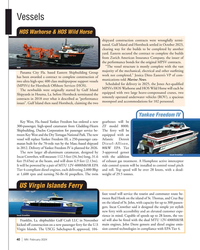 )
February 2024 - Marine News page: 40
)
February 2024 - Marine News page: 40Islands Ferry foot vessel will service the tourist and commuter route be- tween Red Hook on the island of St. Thomas, and Cruz Bay on the island of St. John, with capacity for up to 300 passen- gers. Incat Crowther said it designed the simple yet stylish new ferry with accessibility and an elevated customer
-
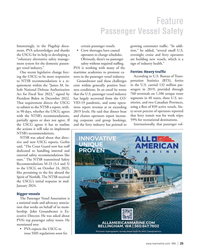 )
February 2024 - Marine News page: 25
)
February 2024 - Marine News page: 25mid- January 2024. Bigger vessels The Passenger Vessel Association is a national trade and advocacy associa- tion that works on behalf of its mem- bership. John Groundwater is Ex- ecutive Director. He was asked about PVA’s top passenger safety issues. He mentioned two: • PVA expects the USCG to issue SMS
-
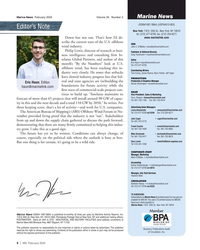 )
February 2024 - Marine News page: 4
)
February 2024 - Marine News page: 4477-6700; fax: (212) 254-6271 www.marinelink.com Down but not out. That’s how I’d de- scribe the current state of the U.S. offshore CEO wind industry. John C. O’Malley • [email protected] Philip Lewis, director of research at busi- Publisher & Editorial Director Greg Trauthwein • trauthwein@marinelink
-
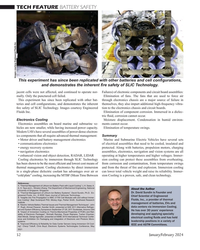 )
January 2024 - Marine Technology Reporter page: 52
)
January 2024 - Marine Technology Reporter page: 52Smith, Southwest Research Institute management of batteries, EVs and 4. “Electric Vehicle Battery Thermal Issues and Thermal Management Techniques”, John data centers via Immersion Cooling. P. Rugh, Ahmad Pesaran, Kandler Smith; presented at SAE 2011 Alternative Refriger- ant and System Ef? ciency
-
 )
January 2024 - Marine Technology Reporter page: 4
)
January 2024 - Marine Technology Reporter page: 4(though not for attribution or reporting) Justin Zuure on the path, direction and importance of the CEO subsea vehicle market. Sitting at that table John C. O’Malley [email protected] that night were several U.S. Navy Admirals as well as the CEOs from about a dozen autonomous underwater vehicle
-
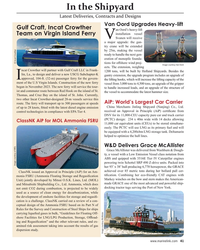 )
January 2024 - Maritime Reporter and Engineering News page: 41
)
January 2024 - Maritime Reporter and Engineering News page: 41ist and commuter route between Red Hook on the island of St. the vessel to accommodate the latest hammer size. Thomas, and Cruz Bay on the island of St. John. Currently, two other Incat Crowther-designed 28-m vessels service this AiP: World’s Largest Car Carrier route. The ferry will transport up to 300
-
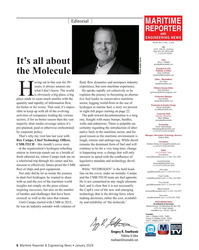 )
January 2024 - Maritime Reporter and Engineering News page: 6
)
January 2024 - Maritime Reporter and Engineering News page: 6Editorial MARITIME REPORTER AND ENGINEERING NEWS M A R I N E L I N K . C O M HQ 118 E. 25th St., 2nd Floor New York, NY 10010 USA T +1.212.477.6700 CEO John C. O’Malley It’s all about [email protected] President & COO Publisher & Editor Greg Trauthwein the Molecule Photo Justin Zurre trauthwein@marinelink
-
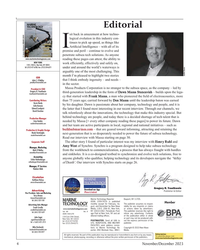 )
November 2023 - Marine Technology Reporter page: 4
)
November 2023 - Marine Technology Reporter page: 4is arguably one of the most challenging. This Justin Zuure month I’m pleased to highlight two stories CEO that I think embody ingenuity – and needs – John C. O’Malley [email protected] in the sector. Massa Products Corporation is no stranger to the subsea space, as the company – led by President
-
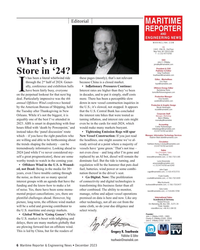 )
December 2023 - Maritime Reporter and Engineering News page: 6
)
December 2023 - Maritime Reporter and Engineering News page: 6Editorial MARITIME REPORTER AND ENGINEERING NEWS M A R I N E L I N K . C O M HQ 118 E. 25th St., 2nd Floor New York, NY 10010 USA T +1 212 477 6700 CEO John C. O’Malley What’s in [email protected] President & COO Publisher & Editor Greg Trauthwein Store in ‘24? [email protected] t has been
-
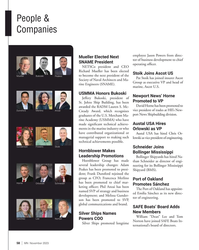 )
November 2023 - Marine News page: 58
)
November 2023 - Marine News page: 58VP and head of rine Engineers (SNAME). marine, Ascot U.S. USMMA Honors Bukoski Newport News’ Horne Jeffery Bukoski, president of Promoted to VP St. Johns Ship Building, has been David Horne has been promoted to awarded the RADM Lauren S. Mc- Merlino Dunsford Anzai Cready Award, which recognizes
-
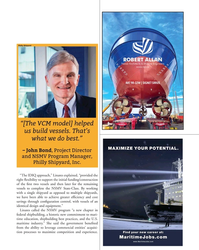 )
November 2023 - Marine News page: 41
)
November 2023 - Marine News page: 41Philly Shipyard “[The VCM model] helped us build vessels. That’s what we do best.” – John Bond, Project Director and NSMV Program Manager, Philly Shipyard, Inc. “The IDIQ approach,” Linares explained, “provided the right ? exibility to support the initial funding/construction of the ? rst two
-
 )
November 2023 - Marine News page: 39
)
November 2023 - Marine News page: 39up to ? ve NSMVs. Keel laying for the Empire State was in May 2021. Ben Christian is TOTE Services’ VP for Business Devel- opment and New Construction. John Bond is Project Di- rector and NSMV Program Manager for Philly Shipyard, Inc. The two were asked for their insights and advisories about the VCM process
-
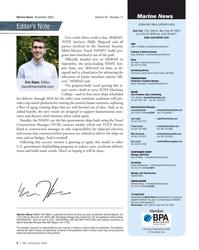 )
November 2023 - Marine News page: 4
)
November 2023 - Marine News page: 4254-6271 www.marinelink.com Give credit where credit is due. MARAD, TOTE Services, Philly Shipyard and all CEO parties involved in the National Security John C. O’Malley • [email protected] Multi-Mission Vessel (NSMV) build pro- Publisher & Editorial Director Greg Trauthwein • trauthwein@marinelink
